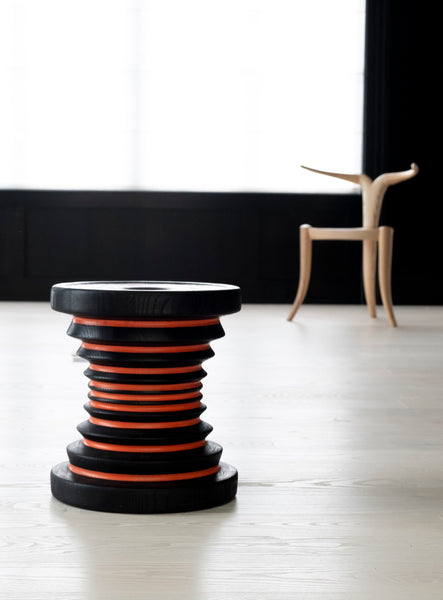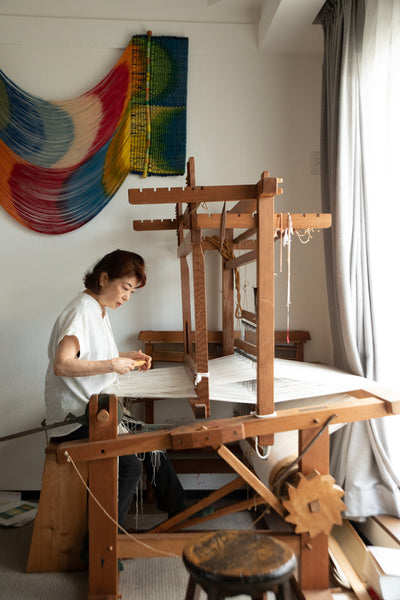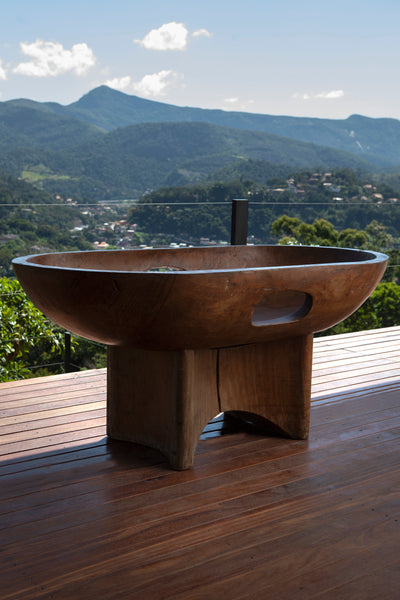Behind the Lens
The Aesthetic of Feeling
Ben Parker of London-based Made Thought on designing beyond the surface for future-facing, 21st-century brands
If you’re reading this, you’re likely well acquainted with Design Miami’s signature forward slash, the essence of our brand identity since the first fair in Basel in 2006. From invitations and advertising in print and digital media to t-shirts, totes, and wayfinding at our events, we communicate nothing without our iconic slash mark in the mix.
In its earliest appearances, the Design Miami slash was deployed rather simply—though always cleverly—mainly as a visual tool to organize information and distinguish the fair’s iterations in different cities. Over the last seventeen years, as the business has grown and times have changed, our identity has evolved and elaborated, progressing from highly controlled, text-focused expressions aerated with lots of white space, to complex, colorful, and pictorial statements that overrun surfaces edge to edge. Through it all, our audience has always been able to recognize us by that ever-present, right-tilting 60° line.
This stroke of branding genius was originated by Made Thought, the creative agency founded by Ben Parker and Paul Austin in London in 2000 and, as of 2021, a member of the The New Standard collective together with Universal Design Studio and Map Project Office. Parker has helmed our account from the start and, along with his talented team, continues to apply his highly refined, deeply considered point of view to everything we do. We’re in good company. Among the many influential, style-conscious brands that tap Made Thought for creative development are Stella McCartney, Tom Dixon, MoMA, Paul Smith, Chandon, and Miami Design District, to name a few.
As Design Miami/ Basel 2023 approaches—accompanied, as always, by its own fair-specific identity designed by Made Thought—we’re bringing Parker from behind the scenes to celebrate the tremendous contribution his agency has made to our brand’s success. “We always start with the aesthetic of feeling,” Parker tells us about the Made Thought approach. “Get the feeling right and the look will swiftly follow.” Read on for more insights from one of the best in the biz.


What is the elevator pitch you use to encapsulate your practice?
Made Thought is a creative office that designs brands to move people. We elevate new stories, ideas, models, and mindsets that make companies more memorable, distinct, understood, and desirable. Our job is to help build a bold and beautiful future in partnership with the world’s most progressive companies.
Where did you grow up, and how did your upbringing impact your professional path?
I grew up in a historic Roman town in Southern England called Winchester. Beautiful but static, it’s a place that tends to look backward to yesteryear and not forward to tomorrow. It refuses to change, which is comforting but ultimately something I started to reject from an early age.
My parents’ home—a Victorian townhouse built in the 1830s from the chalk excavated from the railway line that runs through the town—was full of ancestral brown furniture. I think this backdrop became my stimulus to want and need something different.

Who were your early influences?
I had always enjoyed creating very precise, technical drawings, and this love developed into this thing called graphic design. When I started art school, I was introduced to the work of pioneering Swiss modernist graphic designer Josef Müller-Brockmann. His work, 50 years later, still felt radically contemporary.
But it wasn’t just the look of Müller-Brockmann’s work. It was the progressive, exciting subject matter of the clients he worked for, which ushered in a new age in the 1950s and 1960s. His work brought to life the era’s latest in technology and culture—from architecture, music festivals, and films, to the machines that revolutionized industries. He showed people how to live in a modern world.
My now business partner Paul and I referred to our Müller-Brockmann books as “the bible,” because they became a key inspiration and jump point for the design aesthetic we valued most. Looking back, I now realize that his work became a symbol for the new, teaching us that design is never about the status quo. It’s about redefining it.

What is Made Thought’s origin story?
I met Paul at Ravensbourne College of Design and Communication in London. We founded Made Thought after realizing we worked so well together at university.
We used to have a copywriter's book that showed the mistranslations of Japanese advertising into English. On one page was the slogan, “Here is Made Thought,” which caught our attention. We loved the phrase so much, we took it for our company name.
Our first letterhead had this running boldly across the top, which was all well and good until we began to answer the phone. Imagine saying, “Here is Made Thought,” everytime someone calls. We quickly shortened to Made Thought.
But of course what we loved about the phrase is that it captures the two foundational aspects of what we do. It lets people know that thinking is at the core of who we are and provides the right stimulus to then make ideas manifest.

What was one of Made Thought’s earliest successes that made you feel like you’d chosen the right path?
Our business dramatically shifted when we started to work with Stella McCartney, who is our longest standing client, followed by Design Miami. We helped her create her first signature fragrance bottle. This one project validated us to a broader audience and attracted more visionary clients.
On a more personal level, our work with British design and manufacturing company Established & Sons really made me understand the power of design. This bold and radical upstart allowed us to create an identity that felt very different to the sector. I think the instinct of so many brands is to seek safety and familiarity, but that’s not where brands thrive. Our collaboration with Established & Sons taught me that a brand’s behavior, not just its appearance, is what ultimately defines it; that working with bravery, guts, and risk can have huge rewards.
It was this project that got us noticed by Craig Robins, who invited us to work on Design Miami and, not long after, Miami Design District—two projects we still work on today, more than a decade and half later.

How did you conceive of Design Miami’s identity in the beginning?
The identity is built around a simple idea that manifests as a forward slash. This oblique symbol is used in text to show separation, acting as a dividing line and metaphor to signal the geographic cities that Design Miami appears in. It has become the defining element of the identity.
How has Design Miami’s identity evolved over time?
We’re all looking for something new, different, exciting. And just like people and personalities, brands aren’t magnetized to things that remain static and set in their ways—my time growing up in Winchester proved this!
A brand today must constantly change to remain interesting. Our audience of creatives demands this more than ever. Our job is to keep iterating, experimenting, and seeing how we can flex the identity to stay relevant and unexpected. Yes, a brand needs to be consistent, but not everywhere.

What are some of your favorite past projects for other clients?
That’s a bit like asking which is your favorite child… But I think two stand out.
One is our 12-year-long collaboration with G.F. Smith, a British paper company with nearly 140 years of heritage, providing the finest speciality papers to creative and fashion audiences. Our challenge is to constantly remind people of the beauty, desirability, and potential of this physical, tactile resource in a world that is increasingly digital. This means bringing paper to life in fresh and surprising ways that allow people to re-see and re-value it.
And the second project, Heckfield Place, is one that stands out above all others, because it fundamentally changed me as a designer. It woke me up to understanding that everything in our world is connected; that how we take, make, and waste is all connected. Design and ecology must urgently combine as disciplines, not compete.
Heckfield Place is a hotel that launched in 2018 and, within 6 weeks of opening, won The Times Hotel of the Year Award. Our job was to help reimagine what a hotel, a place of hospitality, means in the 21st century—to obsess over it and bring it to life through the overall strategy, storytelling, and branding design. This 438-acre estate could never just be another beautiful English luxury hotel. In today’s world, it had to stand for more.
Heckfield created an experience of extraordinary care; a “living” ecosystem that shows how we can live differently. It serves as a custodianship not just for the guests but also for the land, the woodlands that surround it, and the soil beneath it that grows biodynamic food free from synthetic chemicals—all done in a progressive, forward-facing way. In its simplest form, it is a grand experiment to understand the estate as an integrated whole that reconnects the house, the regenerative biodynamic Home Farm (the largest in the UK), and the local community back together, like the pre-WWI models that functioned so sustainably before it.
Like all good brands, its stories are not manufactured but come from a fundamental truth. What we helped create was one of the most invisible brands we ever worked on. Our job was to give Heckfield meaning, not branding, because then it will sell itself. Everything is thoughtful but not over-thought. The creative principle “care” is a better word than the ubiquitous and anodyne “sustainability” that we see now in every brief.
What is unique about the way you see design, and how do you translate your way of seeing to others?
Firstly, I think our primary role as brand designers is to tell stories—after all, stories are what make us human and offer lifelines to a better future. And the best stories are linked into how we feel and what we desire.
I think it was Jeff Bezos who, when asked “What will be different in the future?” replied, “What really counts is what will be the same.” If everything else changes, the fundamental human traits will remain constant. That’s what we always try to connect with.
We always start thinking about design through how it feels, not looks. If you get the feeling right, the aesthetic will quickly follow. We believe in creating brands with a wealth of personality. And like human beings, brands with great personality invite us to identify and engage with them.
But the stories about our future are dramatically changing. It is no longer business as usual, and we can no longer see design as purely about the surface of things. In the 21st century, it is about what lies beneath.
With brand design, people now look into you, not just at you. They want to know how you take, make, and waste—how things are created better for people and the planet. The culture of business has shifted from opaque to transparent, because today’s consumers are looking for genuine authenticity, not a smokescreen or veneer.
Now that every business has access to the same talent pool, global insights, business tools, and metrics, creativity is the last competitive advantage. We only need to look at benchmarks like Apple or Nike to reinforce this theory. Brands today are seen as one holistic experience, as complete ecosystems in which every element matters, and every element affects one another. Brands need a fresh perspective that can cut through the complexity, offering simple, integrated solutions with the power to transform.

What skills are you most proud of and why?
I think there are four interconnected skills that creatives need today. The first is to be provocateurs; to actively challenge assumptions. The second is to hold fast to a future-facing vision; to help clients envision and create a different future. The third is to see opportunity in everything, because optimism is the key to transformation. Optimists always start with “What is needed?” rather than “What is wrong?” The unflinching conviction that we can make things better is our most powerful asset. And finally, the ability to fall in love with problems, not with solutions. Our remit is to fall in love with some of the biggest challenges we face, so we can see everything in a very different light. Because if we can see things differently, we can design differently. And that, ultimately, has to be our goal now.

Where do you find inspiration?
I would love to say I find inspiration in art, books, or exhibitions. But it really is in conversations. Building and laddering up ideas with others is the best form of inspiration, because it always takes you somewhere unexpected.
Do you have a dream project that you hope to tackle one day?
The interesting thing about what we do is that we have no specific subject matter of our own. We have to learn (or unlearn) everything about each of our clients. But for too long we’ve been using our skills-for-hire and promoting the wrong things—pushing toxic products, driving poor ideals, and producing only for the short-term.
There is a new generation of creatives seeking projects that build a different future, clients that push back against last century’s briefs, and opportunities to use their skill sets for an entirely different purpose. After all, who wants to be in the business of branded trash? And so there are new questions that creatives (and consumers) are asking: Does your business contribute more to the world than it is taking out? Does it help reduce Earth Overshoot Day?
Businesses that sit within this mindset are certainly the ones we seek out—projects that push for new outcomes, that champion human values and metrics, that look to drive massive shifts in consumer behavior, that reexamine how we make and distribute, that push to eradicate single-use systems. These are the projects I now dream of.
Of course, we’ve always found the most satisfaction comes from working on challenger-brands, often run by visionary founders. They actively challenge the status quo, because they have everything to prove and nothing to lose. They demand a braver and bolder creative input, because it’s so personal and it’s never just about the money. Our clients like Brewdog, A Plastic Planet, Paul Smith, Charlotte Tilbury, and The Nue Co fit this model.
What are you working on next?
We are living in the climate era, which forces every business—along with the creatives they rely on—to transform rapidly and unprecedentedly. When I look at our client roster today, we are working on the most unlikely and unusual projects—ones you didn’t dream of five years ago, let alone at art school, because they didn’t even exist.
Today, we are working on a raft of “regenerative” technology brands that rewrite what has gone before. Because more than ever, our future relies on biologists, chemists, and material scientists informing our understanding of the world's chemistry.
One client that captures this new generation is the game-changing materials science company NFW, based in Ohio. They reflect our new climate era by deploying “fast science” that can reshape our world with radically low-carbon performance materials for every industry, from automobiles to fashion and luxury. They are completely reinventing how we take nutrient ingredients from nature to make useful stuff while keeping those materials clean so they can return to earth safely.
We have all seen the mushroom fungi leathers and the recycled PET bottles from the ocean being used for footwear, textiles, and clothing—this is completely different. Zero toxins, zero petrochemicals, and zero plastics. And critically, like any sustainable initiative that is worth celebrating, it’s about immediate global-level scaling in the billions of units. This science has the power to change everything.
As creatives, our job is no longer the surface facade, a logo, or a campaign—it is about understanding the systems within which our organizations work. Because, like nature, nothing exists in isolation. Everything is dependent on the connected whole for survival. A perfect principle for design thinking as we reinvent our future. ◆
Follow Made Thought on Instagram @made_thought



